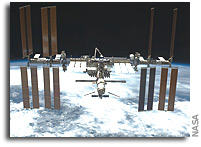NASA International Space Station Lead Increment Scientist’s Weekly Highlights: Jan. 3-14 2011

(Highlights: Jan. 3-14, 2011) — A run of sample 10 with Binary Colloidal Alloy Test-5 (BCAT 5) was completed. BCAT-5 takes pictures of various colloids over time to observe the movement of the particles in microgravity.
Three crew members completed runs with the Psychomotor Vigilance Self Test (Reaction Self Test). The experiment is a portable five-minute reaction time task that allows crew members to monitor the daily effects of fatigue on performance while aboard the station.
One crew member completed a second session of the Dietary Intake Can Predict and Protect Against Changes in Bone Metabolism during Spaceflight and Recovery (Pro K) investigation. It is NASA’s first evaluation of a dietary countermeasure to lessen bone loss of astronauts. Pro K proposes that a flight diet with a decreased ratio of animal protein to potassium will lead to decreased loss of bone mineral. Pro K has impacts on the definition of nutritional requirements and development of food systems for future exploration missions, and yield a method of counteracting bone loss that would have virtually no risk of side effects.
Two test points of Multi-User Droplet Combustion Apparatus – Flame Extinguishment Experiment (MDCA-FLEX) were successfully performed. This experiment will assess the effectiveness of fire suppressants in microgravity and quantify the effect of different possible crew exploration atmospheres on fire suppression. The goal of this research is to provide definition and direction for large scale fire suppression tests and selection of the fire suppressant for next generation crew exploration vehicles.
The first sampling session of the Japan Aerospace Exploration Agency’s Biomedical Analyses of Human Hair Exposed to a Long-term Space Flight (Hair) investigation has been completed. It is believed that by examining human hair the scientists can determine the stress levels and metabolic conditions of a human caused by the microgravity environment and cosmic radiation. The purpose is to study the effects of long-term exposure in spaceflight on gene expression and mineral metabolism in human hair.
Jorge Sotomayor, Lead Increment Scientist Expedition 25/26








